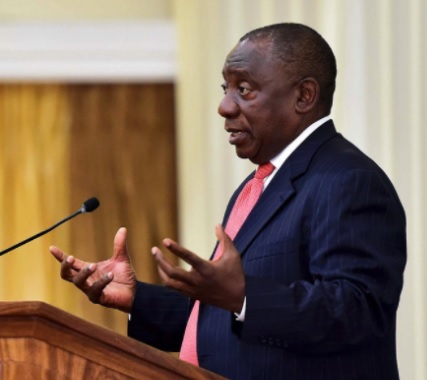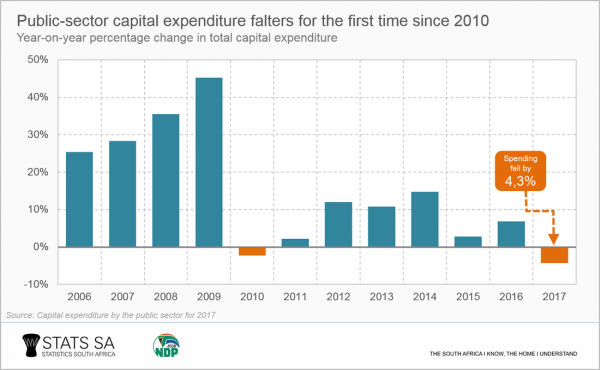

Follow us on:  
|


Ramaphosa’s plan focuses on youth, women and small businesses, but was short on detail [GCIS]
“Fellow South Africans, it is generally agreed that in order for our economy to grow at a rate that will lead to job creation on a meaningful scale we need to significantly increase the level of investment,” said Ramaphosa in Pretoria.
In recent months, structural weaknesses such as a low skilled workforce, inefficient state-owned enterprises and a lack of trust between government and the private sector due to “state capture” have been compounded by a higher oil price, weaker sentiment towards emerging markets, and global trade tensions.
The plan focuses on youth, women and small businesses, but was short on detail and seemed to lack urgency as the timelines were given in terms of months, not days.
For instance within the next few months, the government will review the list of countries requiring visas, an e-visa pilot will be introduced and visa requirements for highly-skilled foreigners will be revised.
In order to reduce the cost of doing business and to boost exports, the government will review various administered prices including electricity, port and rail tariffs, but once again the timeline is months.
On mining, Ramaphosa said the Cabinet has approved the revised mining charter which should provide “certainty” to investors, but as yet this revised mining charter is not in the public domain. The previous draft was rejected by the Minerals Council as the proposed 10% free carry in new projects would kill new investment in the industry.
“It is imperative that South Africa restores investment and exploration levels in the mining sector as mining has significant potential to drive long term growth, enhance exports and increase job creation,” he said.
Another area with “huge potential” for job creation is in agriculture, the president said, but farm land prices have fallen by more than 30% this year in response to the proposed Constitutional change that would allow expropriation without compensation.
The private sector has been invited to join with the government for a new infrastructure fund, with banks, insurance companies and pensions funds said to be ‘hugely excited’ about it after Statistics South Africa reported earlier this year that public sector capital expenditure spending had dropped in nominal terms in 2017 for the first time since 2010 with a 4.3 per cent drop.
Ramaphosa said roads, schools, and public transport were some of the areas set to benefit from the renewed focus on driving infrastructure spend.
Professor Raymond Parsons from the North West University Business School said the plan was a step in the right direction.
“Given the constraints under which any economic stimulus package must now be prepared in South Africa, what was announced today by President Ramaphosa is a necessary step in the right direction of wanting to address certain key issues which have been badly damaging SA’s economic performance,” Parsons said.
It could help to move South Africa out of its recession talk and underpin prospects for modest positive growth in 2018. Much of it emphasizes better planning and improved use of existing resources in order to boost growth and employment, especially investment in agriculture, townships and infrastructure.
This should be welcomed but details will only be available in the Medium Term Budget Policy Statement on October 24.
The private sector
There seems to be a larger role being assigned to the private sector and in reducing uncertainty in sectors such as mining, tourism and land reform.

Although the package shows renewed political determination the success of yet another economic ‘plan’ will depend on the efficacy of President Ramaphosa’s restructured implementation processes, as well as the extent to which the latest package reduces the ‘trust deficit’ between the public and private sectors.
The package will succeed to the extent it ultimately helps to rebuild consumer and business confidence, which time will tell,” Parsons told The BRICS Post.
Opposition political parties were not enthused about the stimulus plan.
“The ‘stimulus and recovery plan’ is aimed at speeding up the implementation of existing economic policies, rather than introducing new economic policies, such as exempting small businesses employing fewer than 250 employees from complying with restrictive labour legislation, other than the basic conditions of employment, in South Africa,” official opposition Democratic Alliance (DA) Shadow Minister of Finance David Maynier said.
“In the end, the ‘stimulus and recovery plan’ is likely to have a modest effect on economic growth and job creation, and it is likely to be compromised by reckless economic policy proposals being considered, such as the formation of state banks, land expropriation without compensation and the nationalisation of the South African Reserve Bank,” Maynier added.
The populist socialist Economic Freedom Fighters party was equally scathing in its reaction.
“Ramaphosa has announced nothing new, but an attempt to repackage old neo-liberal economic plans that have proven futile; they have failed to grow the economy and create sustainable jobs.
The stimulus package has nothing to do with the overall structural changes of the economy.
The promise of radical economic transformation which he made noises about prior to being elected President has been compromised at the table of cosmetic changes to an economy whose essence is the marginalisation of the black majority from the country’s wealth,” the Economic Freedom Fighters said.
Western Cape MEC of Economic Opportunities Alan Winde, who is the DA candidate for the premiership of the Western Cape in 2019, welcomed the announcement of a friendlier visa regime as the Western Cape is one of the country’s tourist hotspots.
“The tightening of the visa regime in 2014 had severe consequences for our tourism sector, a major income provider for residents in our region. The hospitality sector reported widespread cancellations, with travel from some markets, such as China, being particularly constrained,” he said.
The Tourism 2017 report by Statistics South Africa showed that although there was a strong rebound in 2016 and 2017, the country was still suffering from the misguided imposition of more stringent visa requirements in October 2014, as the number of overseas tourists from South Africa’s BRICS partners, remained below their 2013 levels.
The visa requirements were relaxed and the capacity to process them was improved in 2015 and 2016 in a belated attempt to mitigate the effects on the tourism industry.
As ten tourists are estimated to create one job, the 84 110 drop in BRIC tourist numbers from 359,429 in 2013 to 275,319 in 2017 has cost some 8,000 jobs at a time when the unemployment rate exceeds 27 per cent.
Helmo Preuss in Tsitsikamma, South Africa for The BRICS Post